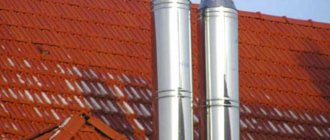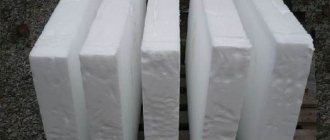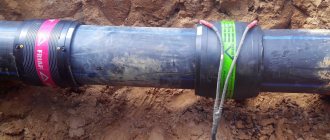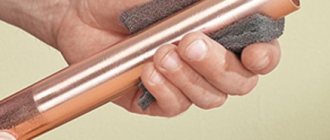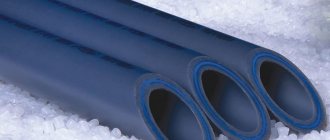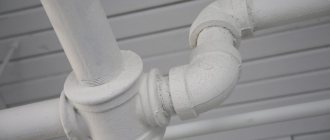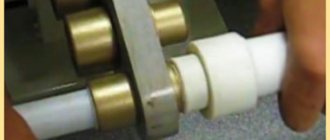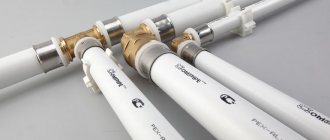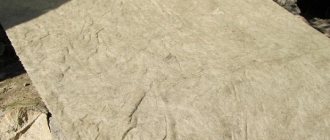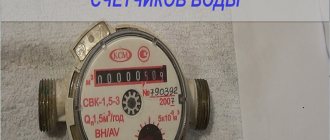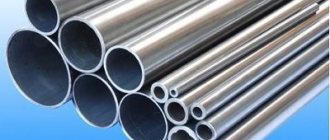Galvanized pipe insulation is an engineering measure carried out when laying communication networks of various lengths and configurations. Shaped products are used in the arrangement of residential buildings, administrative and commercial buildings. They are used for finishing deep-lying highways, ground and air passages, in water supply, ventilation, air conditioning, sewerage and heating systems.
Galvanized pipe insulation
Purpose of galvanized protective covers
When laying channels for transporting liquids and gases, steel, plastic and asbestos-cement segments are used. These materials are not resistant to mechanical stress, dampness and ultraviolet radiation. With temperature changes, the risk of overheating or freezing of the transported substance increases. Foam and roll insulation for pipes needs protection from external influences. For this purpose, it is enclosed in a durable and lightweight casing made of galvanized steel.
Engineering problems solved using thermal insulation of pipelines:
- Maintaining the temperature regime of the material transported along the line. The insulation contained inside the product completely eliminates the influence of the external environment.
- Protection from mechanical influences. Metal resists pressure and impact, including from sharp objects. Stiffening ribs increase the strength of the cylinder.
- Foundation waterproofing. The products are used for the installation of drainage systems in conditions of high groundwater levels.
- Protection of communications from moisture, solar radiation, vibration and deformation.
- Preventing the appearance of condensation on the inner surface. This increases the service life of the chimney pipes and makes their maintenance easier.
- Protection of surrounding objects and people from contact with hot lines in domestic and industrial conditions.
A large selection of products expands the scope of their application.
Polyurethane foam insulation
Polyurethane foam is applied to the surface of pipes by spraying. Voratek and Izolan polyurethane foam insulators are used to protect standard steel and galvanized pipelines: the materials are environmentally friendly due to their environmentally friendly composition. If the application technology is followed, they increase the service life of metal structures to 30 years or more. Protection is often enhanced by galvanized polyethylene coating.
The disadvantages of pipes with polyurethane foam include flammability, destruction under the influence of ultraviolet radiation, the need to completely replace damaged ones when moisture is detected - repairs are impractical. Inside the polyurethane foam layer, a SODC is installed - an operational remote monitoring system that uninterruptedly monitors problems in the functioning of the insulation. It is used to control the humidity level and other indicators of the system.
Pipes with polyurethane foam insulation are manufactured according to GOST 30732-2006. The standard lists the requirements for products and indicates the permissible technical indicators of the insulating layer:
- maximum thermal conductivity at 50 degrees Celsius – 0.033 W/m°C;
- minimum strength during deformation/compression – 0.3 MPa;
- minimum density – 60 kg/m³.
Insulated polyurethane foam pipes can withstand significant loads (temperatures up to 140 degrees, pressure up to 1.5 MPa), therefore they are often used for laying underground/ground heating mains.
Properties and technical characteristics of the coating
Basalt wool, polystyrene foam and polyurethane foam are used as insulating filler. These materials practically do not allow heat to pass through and are hydrophobic. PPU shell coated with paint and varnish can withstand ultraviolet radiation for a long time. Insulating technology for pipeline insulation provides additional protection for the internal filler.
An alternative to concrete channels are metal cylinders. The casings are made from solid rolls of premium quality galvanized iron. In the process of shaping the product, indentations are made on its walls, playing the role of stiffening ribs. The edges are connected and pressed, forming a sealed joint into which gas and water do not penetrate. Locking elements at the ends ensure simplicity and quality of assembly. After installation of the structure, a solid and sealed pipe is obtained, which is guaranteed to insulate and protect internal communications.
Technical characteristics of finished products:
- metal - thin sheet galvanized steel of class 1 or 2 (GOST 14918-80);
- sheet metal thickness - 0.55-1.00 mm;
- internal diameter - 100, 200, 320, 500, 1000, 1200, 1600 mm;
- section length - 80, 100, 120, 125 cm;
A high-quality casing should have a smooth surface of uniform color without chips, dents, scratches or rust. When installing pipelines on the surface, the metal is treated with powder coating.
Structure of reinforced protective coatings
Construction and coating material | Layer thickness or number of layers |
| 1. Coatings based on bitumen mastics | |
| Bitumen primer | 0.05 mm |
| Bitumen mastic | 2.5 mm |
| Reinforcing winding | — |
| Bitumen mastic | 2.5 mm |
| Reinforcing winding | — |
| Bitumen mastic | 2.5 mm |
| Outer wrap | — |
| 2.Coating based on polymer adhesive tapes | |
| Primer (primer) | 0.1 mm |
| Duct tape | 2 layers |
| Wrapper | 1 layer |
| 3. Extruded polyethylene coatings | |
| Adhesive | 0.15 |
| Extruded polyethylene for pipes with a diameter of 500 mm and above | 3.5 mm |
Note: It is allowed to use coatings of other structures that provide protection according to regulatory and technical documentation.
Before applying the primer, the surface of the insulated pipes is dried, cleaned of dirt, rust loosely adhered to the metal, scale and dust. After cleaning, the metal surface must be rough to ensure, together with the primer, sufficient adhesion of the insulating coating to the pipe. Pipe cleaning is carried out with special cleaning machines. Shaped surfaces and welded joint areas are cleaned manually with flat or rotating brushes. The primer is applied immediately after cleaning the pipe surface, in an even layer without gaps, clots or bubbles. The thickness of the dried primer layer should not exceed 0.05 mm. The coating of the pipe should be carried out no later than 24 hours after applying the primer.
The mastic is applied around the circumference and length of the pipe in an even layer of a given thickness without bubbles or foreign inclusions. A layer of fiberglass reinforcing winding must be applied to the hot mastic in a spiral with an overlap and a certain tension, eliminating voids, wrinkles and folds and ensuring the continuity of the layer and the required thickness of the protective coating.
Carrying out insulation work in winter under route conditions is allowed at an air temperature of at least minus 25°C and in the absence of precipitation. Bitumen mastics are recommended for use on gas pipelines with a diameter of up to 500 mm and operating temperatures up to 35°C. The reliability of the bitumen coating increases significantly with an increase in the number of reinforcing layers of fiberglass with the use of protective wraps. Currently, the most effective polymer mastic is the two-component mastic “Frusis-1000A”. The mastic is applied under route conditions and is intended for anti-corrosion protection of hot areas of underground communications of compressor stations.
Mastic curing time 30...60 min.,
The thickness of the applied coating is 2.5…3.0 mm,
Operating temperature up to 80°C.
Design and types of products
Protective covers are supplied ready for installation. No additional measures are required with the products. Before installation, it is necessary to remove the shipping film from the cylinder, which protects the product from dust, dirt and scratches.
The line can be assembled using links with different diameters. In addition, channels have bends, turns and joints.
To ensure that the coating structure is insulated and sealed throughout, the following shaped products are used:
- Straight cylindrical. They look like a solid ring with riveted edges and end locks. They are placed on chimneys after they are erected.
- Straight open. They are split cylinders equipped with locking elements on the sides and ends. Installed on underground, overhead and surface pipelines.
- Round tees. Designed for installation on the nodal sections of the channel, where three directions are connected.
- Conical. Installed on the final link of a ventilation or chimney duct. The narrowing is intended for installation of a protective fungus.
- Bends. They look like a curved oblong ring. Used to protect rotary sections of pipelines.
- Detachable boxes. They are a prefabricated part of a spherical, cubic or complex shape. Installed on shut-off and control valves, coupling and flange joints.
- Plugs. They look like saucers with vertical walls. Serve to isolate dead-end sections of utility lines.
- Zeppelins. Used to protect tanks and technical containers.
Complete with casings and fittings, it is recommended to purchase rivets and self-tapping screws to strengthen the fastening of stressed areas.
Types of shaped products
Insulating casings are made from sheet metal using the hot-rolled method. Depending on the section of the pipeline on which the protective elements will be installed, the metal is given the appropriate shape during the manufacturing process. According to it, protective covers are divided into the following types:
- simple cylindrical - have the appearance of an open cylinder with locking elements;
- installed on straight sections of pipelines according to the shell principle;
- tees - used to protect the node section of the network into which the outlet pipe is embedded;
- bends - products designed to protect a section of pipe running at a slight angle;
- conical casings - placed on the head of a chimney pipe or ventilation outlet on the roof;
- end caps – used to protect dead-end sections of utility networks;
- Zeppelin - used for insulating containers and reservoirs;
- split boxes – designed to protect shut-off valves, flange and coupling connections.
We recommend that you read: Types of chimneys for stoves with a long-burning system and which one is better to choose
Important! There are no standard parameters among manufacturers for the manufacture of protective covers. Most products are based on durable sheet metal with a thickness of 0.3-55 mm. The most popular shaped products on the market are 1000, 1200 and 1250 mm long, made of galvanized steel. You can find casings painted with polymer powder paint in any color.
Advantages of protective coating
Steel casing for pipe insulation has the following advantages:
- Affordable price. In the manufacture of shaped parts, inexpensive raw materials are used, and the production process itself is almost completely automated.
- Simplicity and high speed of installation. Ready-to-use products are installed quickly. The process requires no effort.
- Long service life. The polymer anti-corrosion coating reliably protects the metal and filler from moisture. Manufacturers provide a 12-15 year guarantee on their products.
- Possibility of dismantling and subsequent installation. In an emergency, it is possible to gain access to a damaged section of the network.
- Ease. The sections weigh little, they are convenient to load, transport, stack and transport to the place of work.
- Presentable appearance. The coating looks great in any environment. The shine can be dulled with matte paint.
- Wide operating temperature range. Galvanized steel and heat insulation do not change their properties in conditions of extreme frost and heat.
Steel casings have a large margin of safety, protecting pipelines from mechanical damage.
Scope of application and installation features
Coating the surface of pipeline insulation with galvanized steel creates a solid thermal barrier between the material carrier and the environment.
Products are used for insulation of the following engineering structures:
- cold and hot water supply;
- contour water heating;
- sewerage laid above the ground freezing level;
- ventilation ducts located in the ground or in the open air;
- steel, ceramic and asbestos-cement chimneys;
- exhaust pipes of units and mechanisms;
- technological lines through which hot media circulates.
The recommended method for installing enclosures does not require the use of special equipment or welding. All actions are performed manually, without lifting devices. Before installing the heat insulator, the network section must be cleaned of dirt and rust, and then coated with an anti-corrosion agent.
Installation should begin from the point where the pipeline exits the facility. Depending on the configuration of the highway, segments are strung or fastened onto it. The joints can be fixed with hardware intended for such purposes. To increase the reliability of connections, composite plastic, mastic or aluminum tape can be used.
